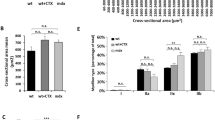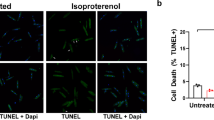Abstract
Adeno-associated virus (AAV) has become a leading gene transfer vector for striated muscles. However, the AAV vectors also exhibit broad tropisms after systemic delivery. In an attempt to improve muscle tropism, we inserted a 7-amino-acid (ASSLNIA) muscle-targeting peptide (MTP) in the capsids of AAV2 at residue 587 or 588, generating AAV587MTP and AAV588MTP. In vitro studies showed that both viruses diminished their infectivity on non-muscle cell lines as well as on un-differentiated myoblasts; however, preserved or enhanced their infectivity on differentiated myotubes. AAV587MTP, but not AAV588MTP, also abolished its heparin-binding capacity and infected myotubes in a heparin-independent manner. Furthermore, in vivo studies by intravenous vector administration in mice showed that AAV587MTP enhanced its tropism to various muscles and particularly to the heart (24.3-fold of unmodified AAV2), whereas reduced its tropism to the non-muscle tissues such as the liver, lungs, spleen and so on. This alteration of tissue tropism is not simply because of the loss of heparin-binding, as a mutant AAV2 (AAVHBSMut) containing heparin-binding site mutations lost infectivity on both non-muscle and muscle cells. Furthermore, free MTP peptide, but not the scrambled control peptide, competitively inhibited AAV587MTP infection on myotubes. These results suggest that AAV2 could be re-targeted to the striated muscles by a MTP inserted after residue 587 of the capsids. This proof of principle study showed first evidence of peptide-directed muscle targeting on systemic administration of AAV vectors.
This is a preview of subscription content, access via your institution
Access options
Subscribe to this journal
Receive 12 print issues and online access
$259.00 per year
only $21.58 per issue
Buy this article
- Purchase on Springer Link
- Instant access to full article PDF
Prices may be subject to local taxes which are calculated during checkout






Similar content being viewed by others
References
Cox GA, Cole NM, Matsumura K, Phelps SF, Hauschka SD, Campbell KP et al. Overexpression of dystrophin in transgenic mdx mice eliminates dystrophic symptoms without toxicity. Nature 1993; 364: 725–729.
Amalfitano A, McVie-Wylie AJ, Hu H, Dawson TL, Raben N, Plotz P et al. Systemic correction of the muscle disorder glycogen storage disease type II after hepatic targeting of a modified adenovirus vector encoding human acid-alpha-glucosidase. Proc Natl Acad Sci USA 1999; 96: 8861–8866.
Kessler PD, Podsakoff GM, Chen X, McQuiston SA, Colosi PC, Matelis LA et al. Gene delivery to skeletal muscle results in sustained expression and systemic delivery of a therapeutic protein. Proc Natl Acad Sci USA 1996; 93: 14082–14087.
Greelish JP, Su LT, Lankford EB, Burkman JM, Chen H, Konig SK et al. Stable restoration of the sarcoglycan complex in dystrophic muscle perfused with histamine and a recombinant adeno-associated viral vector. Nat Med 1999; 5: 439–443.
Wolff JA, Malone RW, Williams P, Chong W, Acsadi G, Jani A et al. Direct gene transfer into mouse muscle in vivo. Science 1990; 247: 1465–1468.
Wolff JA, Ludtke JJ, Acsadi G, Williams P, Jani A . Long-term persistence of plasmid DNA and foreign gene expression in mouse muscle. Hum Mol Genet 1992; 1: 363–369.
Xiao X, Li J, Samulski RJ . Efficient long-term gene transfer into muscle tissue of immunocompetent mice by adeno-associated virus vector. J Virol 1996; 70: 8098–8108.
Blankinship MJ, Gregorevic P, Allen JM, Harper SQ, Harper H, Halbert CL et al. Efficient transduction of skeletal muscle using vectors based on adeno-associated virus serotype 6. Mol Ther 2004; 10: 671–678.
Kay MA, Manno CS, Ragni MV, Larson PJ, Couto LB, McClelland A et al. Evidence for gene transfer and expression of factor IX in haemophilia B patients treated with an AAV vector. Nat Genet 2000; 24: 257–261.
Gregorevic P, Blankinship MJ, Allen JM, Crawford RW, Meuse L, Miller DG et al. Systemic delivery of genes to striated muscles using adeno-associated viral vectors. Nat Med 2004; 10: 828–834.
Wang Z, Zhu T, Qiao C, Zhou L, Wang B, Zhang J et al. Adeno-associated virus serotype 8 efficiently delivers genes to muscle and heart. Nat Biotechnol 2005; 23: 321–328.
Monahan PE, Samulski RJ . AAV vectors: is clinical success on the horizon? Gene Therapy 2000; 7: 24–30.
Summerford C, Samulski RJ . Membrane-associated heparan sulfate proteoglycan is a receptor for adeno-associated virus type 2 virions. J Virol 1998; 72: 1438–1445.
Summerford C, Bartlett JS, Samulski RJ . AlphaVbeta5 integrin: a co-receptor for adeno-associated virus type 2 infection. Nat Med 1999; 5: 78–82.
Qing K, Mah C, Hansen J, Zhou S, Dwarki V, Srivastava A . Human fibroblast growth factor receptor 1 is a co-receptor for infection by adeno-associated virus 2. Nat Med 1999; 5: 71–77.
Kashiwakura Y, Tamayose K, Iwabuchi K, Hirai Y, Shimada T, Matsumoto K et al. Hepatocyte growth factor receptor is a coreceptor for adeno-associated virus type 2 infection. J Virol 2005; 79: 609–614.
Asokan A, Hamra JB, Govindasamy L, Agbandje-McKenna M, Samulski RJ . Adeno-associated virus type 2 contains an integrin alpha5beta1 binding domain essential for viral cell entry. J Virol 2006; 80: 8961–8969.
Barry MA, Dower WJ, Johnston SA . Toward cell-targeting gene therapy vectors: selection of cell-binding peptides from random peptide-presenting phage libraries. Nat Med 1996; 2: 299–305.
Muller OJ, Kaul F, Weitzman MD, Pasqualini R, Arap W, Kleinschmidt JA et al. Random peptide libraries displayed on adeno-associated virus to select for targeted gene therapy vectors. Nat Biotechnol 2003; 21: 1040–1046.
Wu P, Xiao W, Conlon T, Hughes J, Agbandje-McKenna M, Ferkol T et al. Mutational analysis of the adeno-associated virus type 2 (AAV2) capsid gene and construction of AAV2 vectors with altered tropism. J Virol 2000; 74: 8635–8647.
Loiler SA, Conlon TJ, Song S, Tang Q, Warrington KH, Agarwal A et al. Targeting recombinant adeno-associated virus vectors to enhance gene transfer to pancreatic islets and liver. Gene Ther 2003; 10: 1551–1558.
Grifman M, Trepel M, Speece P, Gilbert LB, Arap W, Pasqualini R et al. Incorporation of tumor-targeting peptides into recombinant adeno-associated virus capsids. Mol Ther 2001; 3: 964–975.
Nicklin SA, Buening H, Dishart KL, de Alwis M, Girod A, Hacker U et al. Efficient and selective AAV2-mediated gene transfer directed to human vascular endothelial cells. Mol Ther 2001; 4: 174–181.
White SJ, Nicklin SA, Buning H, Brosnan MJ, Leike K, Papadakis ED et al. Targeted gene delivery to vascular tissue in vivo by tropism-modified adeno-associated virus vectors. Circulation 2004; 109: 513–519.
Work LM, Buning H, Hunt E, Nicklin SA, Denby L, Britton N et al. Vascular bed-targeted in vivo gene delivery using tropism-modified adeno-associated viruses. Mol Ther 2006; 13: 683–693.
Samoylova TI, Smith BF . Elucidation of muscle-binding peptides by phage display screening. Muscle Nerve 1999; 22: 460–466.
Samoylov AM, Samoylova TI, Hartell MG, Pathirana ST, Smith BF, Vodyanoy V . Recognition of cell-specific binding of phage display derived peptides using an acoustic wave sensor. Biomol Eng 2002; 18: 269–272.
Pacak CA, Mah CS, Thattaliyath BD, Conlon TJ, Lewis MA, Cloutier DE et al. Recombinant adeno-associated virus serotype 9 leads to preferential cardiac transduction in vivo. Circ Res 2006; 99: e3–e9.
Inagaki K, Fuess S, Storm TA, Gibson GA, McTiernan CF, Kay MA et al. Robust systemic transduction with AAV9 vectors in mice: efficient global cardiac gene transfer superior to that of AAV8. Mol Ther 2006; 14: 45–53.
Shi W, Arnold GS, Bartlett JS . Insertional mutagenesis of the adeno-associated virus type 2 (AAV2) capsid gene and generation of AAV2 vectors targeted to alternative cell-surface receptors. Hum Gene Ther 2001; 12: 1697–1711.
Park PW, Reizes O, Bernfield M . Cell surface heparan sulfate proteoglycans: selective regulators of ligand-receptor encounters. J Biol Chem 2000; 275: 29923–29926.
Thomas CE, Storm TA, Huang Z, Kay MA . Rapid uncoating of vector genomes is the key to efficient liver transduction with pseudotyped adeno-associated virus vectors. J Virol 2004; 78: 3110–3122.
Margalit H, Fischer N, Ben-Sasson SA . Comparative analysis of structurally defined heparin binding sequences reveals a distinct spatial distribution of basic residues. J Biol Chem 1993; 268: 19228–19231.
Huttner NA, Girod A, Perabo L, Edbauer D, Kleinschmidt JA, Buning H et al. Genetic modifications of the adeno-associated virus type 2 capsid reduce the affinity and the neutralizing effects of human serum antibodies. Gene Therapy 2003; 10: 2139–2147.
Xie Q, Bu W, Bhatia S, Hare J, Somasundaram T, Azzi A et al. The atomic structure of adeno-associated virus (AAV-2), a vector for human gene therapy. Proc Natl Acad Sci USA 2002; 99: 10405–10410.
Schwede T, Kopp J, Guex N, Peitsch MC . SWISS-MODEL: An automated protein homology-modeling server. Nucleic Acids Res 2003; 31: 3381–3385.
Guex N, Peitsch MC . SWISS-MODEL and the Swiss-PdbViewer: an environment for comparative protein modeling. Electrophoresis 1997; 18: 2714–2723.
Chirmule N, Propert K, Magosin S, Qian Y, Qian R, Wilson J . Immune responses to adenovirus and adeno-associated virus in humans. Gene Therapy 1999; 6: 1574–1583.
Scallan CD, Jiang H, Liu T, Patarroyo-White S, Sommer JM, Zhou S et al. Human immunoglobulin inhibits liver transduction by AAV vectors at low AAV2 neutralizing titers in SCID mice. Blood 2006; 107: 1810–1817.
Li J, Samulski RJ, Xiao X . Role for highly regulated rep gene expression in adeno-associated virus vector production. J Virol 1997; 71: 5236–5243.
Xiao X, Li J, Samulski RJ . Production of high-titer recombinant adeno-associated virus vectors in the absence of helper adenovirus. J Virol 1998; 72: 2224–2232.
Acknowledgements
We thank Dr Zhong Wang for helpful advice and Ms Chunlian Chen for technical assistance. This work is part of C Yu's PhD thesis at the University of Pittsburgh. It is supported by NIH grants AR45967 and AR50595 to X Xiao.
Author information
Authors and Affiliations
Corresponding author
Rights and permissions
About this article
Cite this article
Yu, CY., Yuan, Z., Cao, Z. et al. A muscle-targeting peptide displayed on AAV2 improves muscle tropism on systemic delivery. Gene Ther 16, 953–962 (2009). https://doi.org/10.1038/gt.2009.59
Received:
Revised:
Accepted:
Published:
Issue Date:
DOI: https://doi.org/10.1038/gt.2009.59
Keywords
This article is cited by
-
Identification of a myotropic AAV by massively parallel in vivo evaluation of barcoded capsid variants
Nature Communications (2020)
-
Tailoring the AAV2 capsid vector for bone-targeting
Pediatric Research (2018)
-
Site Specific Modification of Adeno-Associated Virus Enables Both Fluorescent Imaging of Viral Particles and Characterization of the Capsid Interactome
Scientific Reports (2017)
-
Emerging Gene Therapies for Genetic Hearing Loss
Journal of the Association for Research in Otolaryngology (2017)
-
Pulmonary Targeting of Adeno-associated Viral Vectors by Next-generation Sequencing-guided Screening of Random Capsid Displayed Peptide Libraries
Molecular Therapy (2016)



